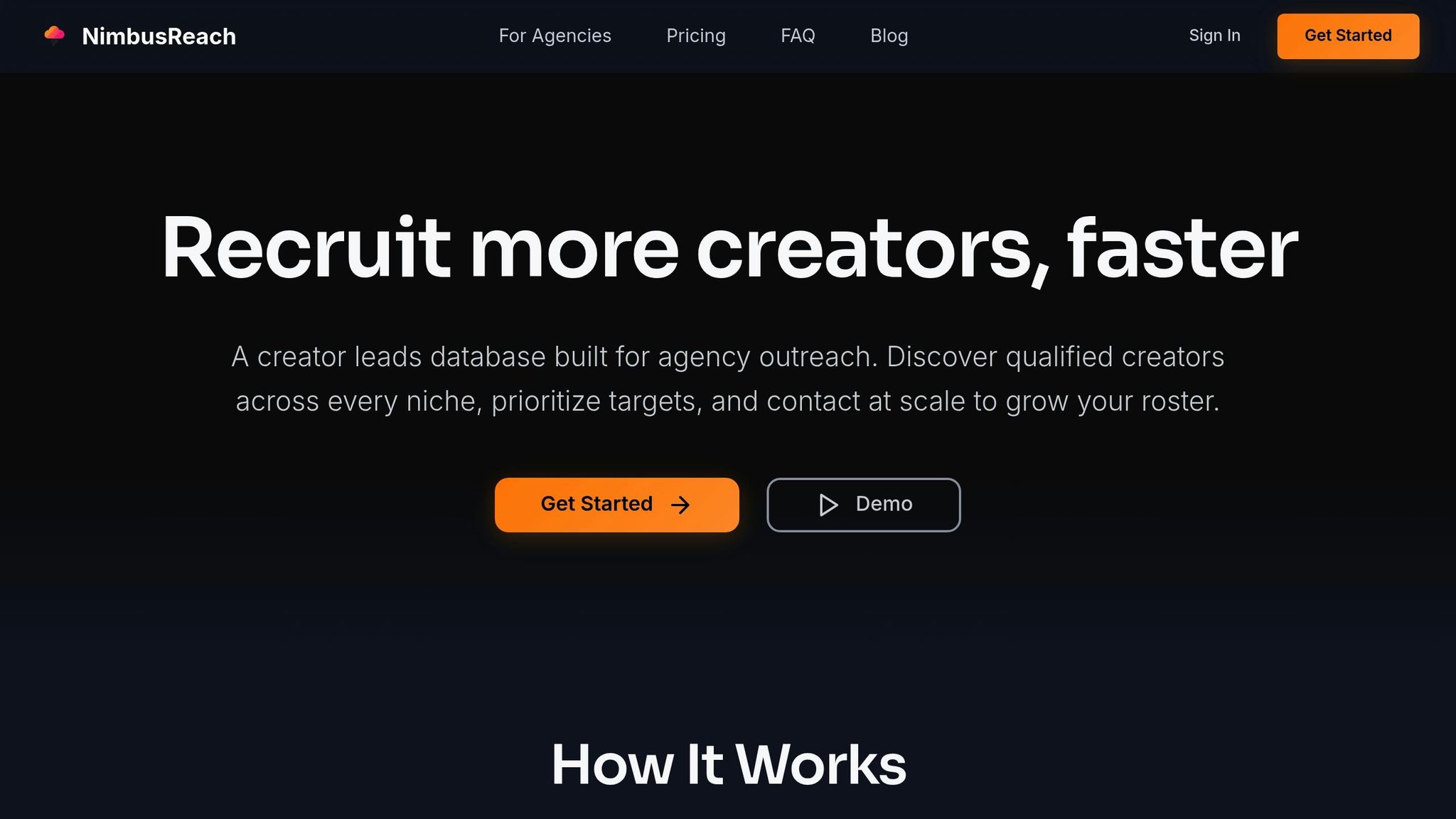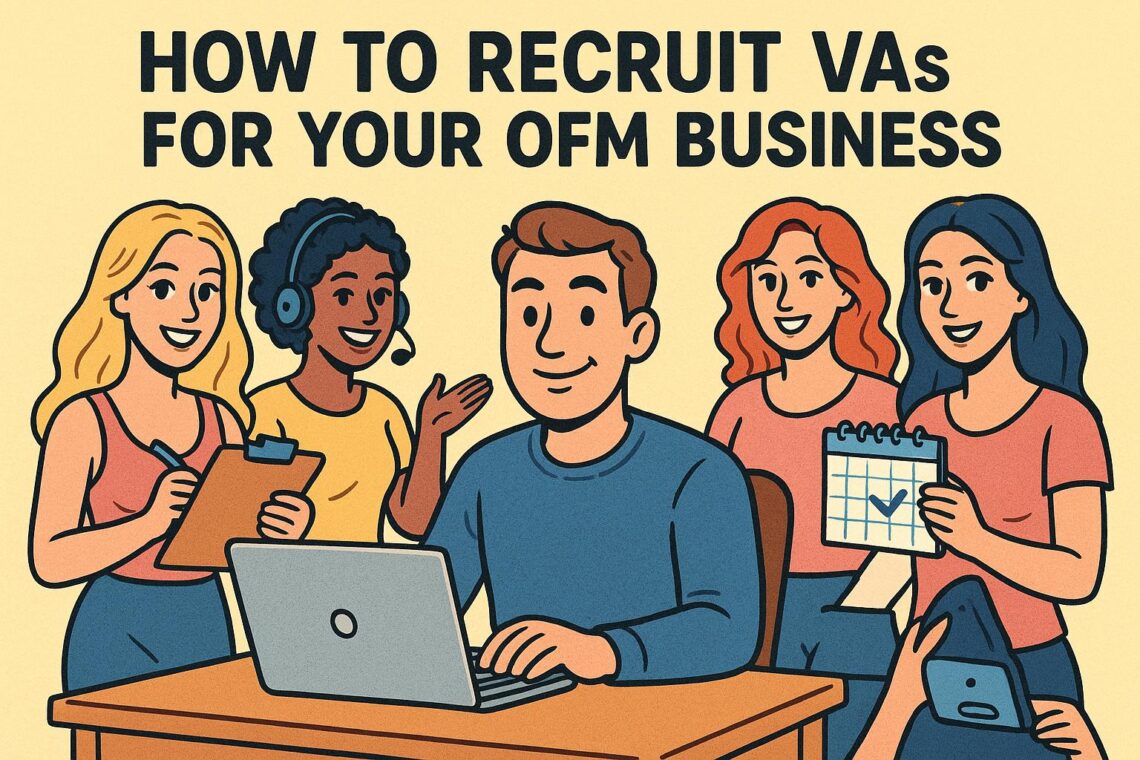Running an OnlyFans Management (OFM) business can be overwhelming. Managing fan engagement, scheduling content, and handling admin tasks across multiple creators often leads to burnout. Virtual assistants (VAs) can help by taking over repetitive tasks, ensuring smooth operations, and allowing you to focus on growth.
Why hire VAs for OFM?
- They handle time-consuming tasks like fan messages, content scheduling, and customer service.
- VAs ensure consistent service quality and 24/7 engagement by working across time zones.
- Delegating tasks means you can onboard more creators and scale your business effectively.
Steps to recruit and manage VAs:
- Define roles: Outline specific tasks like chat management, scheduling, or admin duties.
- Find candidates: Use platforms like Upwork, Freelancer, or LinkedIn to hire skilled VAs.
- Interview smartly: Test communication, discretion, and problem-solving with scenario-based questions.
- Onboard effectively: Provide clear SOPs, tools, and training for a smooth start.
- Use tools: Platforms like Asana and NimbusReach help track tasks and improve efficiency.
How To Hire a Virtual Assistant | Upwork

Key Responsibilities for VAs in OFM
When bringing virtual assistants (VAs) into your OnlyFans Management (OFM) business, it’s crucial to clearly define their roles and responsibilities. Each VA’s tasks should align with your agency’s goals for revenue and growth, ensuring their contributions directly support your objectives. These role definitions serve as the foundation for their work and your agency’s success.
Main Tasks for OFM VAs
Lay out the primary tasks your VAs will handle. These should be focused on activities that drive revenue and contribute to the agency’s overall growth. By setting clear expectations, you help your team understand how their work impacts the bigger picture.
Required Skills and Attributes
Focus on key attributes like strong written communication, strict adherence to processes, and a dedication to continuous learning. Providing formal training and mentorship can help your VAs quickly develop the skills they need to excel in their roles.
Understanding OFM-Specific Requirements
Beyond mastering general skills, VAs need to understand the unique aspects of OFM operations. Explain how their tasks directly influence the agency’s performance and offer structured opportunities for skill development. This not only equips your team with the tools they need but also encourages an entrepreneurial mindset. A well-trained, motivated VA team can help streamline recruitment and support the long-term growth of your agency.
Where and How to Find Qualified VAs
Finding the right virtual assistants (VAs) for your OFM business requires a clear strategy. Knowing where to search and how to identify skilled candidates can make all the difference in building a reliable team.
Best Platforms to Find OFM VAs
Freelancing platforms are a great starting point. Websites like Upwork, Freelancer, and Fiverr host a wide range of candidates with varying skill sets. When creating your job listing, include specific keywords like "social media management," "customer service," or "content scheduling" to attract candidates experienced in tasks relevant to OFM operations.
Remote job boards such as Remote.co, We Work Remotely, and FlexJobs are also excellent options. These platforms often attract individuals seeking long-term roles and who demonstrate strong communication skills and a solid work ethic.
Social media networks like LinkedIn, Twitter, and Instagram can also be valuable tools. Focus on candidates with experience in areas like digital marketing, customer service, or social media management. These platforms allow you to directly engage with potential hires, giving you insight into their expertise and professional presence.
For a more data-driven approach, tools like NimbusReach can provide analytics on creator performance and engagement. This information can help you refine your job descriptions and target candidates who are better suited for your specific needs.
How to Interview and Assess VA Candidates
Once you’ve narrowed down your list of potential candidates, the interview process becomes crucial. It’s your opportunity to evaluate not just technical skills but also the communication, discretion, and problem-solving abilities that are essential for managing OFM tasks effectively.
Running Effective Interviews
Start the interview with a friendly, conversational tone to put candidates at ease. This approach encourages open and honest responses. Since VAs will be interacting with fans daily – whether through messages or comments – pay close attention to their communication clarity. Are they articulate? Do they strike the right tone? Can they explain complex ideas in a simple and approachable way?
Another key trait to assess is flexibility. OFM work often involves juggling multiple creators, each with unique schedules, content styles, and fan interactions. Ask candidates to share examples of situations where they had to quickly adapt to shifting priorities or manage demanding clients.
Discretion is equally critical. Candidates need to demonstrate a strong sense of professionalism, especially when discussing previous roles. Confidentiality is a cornerstone of this industry, and you’ll want someone who understands its importance without constant reminders. Observe how they handle sensitive topics – do they speak respectfully about past clients? Can they discuss challenges without oversharing? These are strong indicators of how they’ll manage the private and often sensitive nature of OFM work.
Using Scenario-Based Questions
Scenario-based questions are a powerful way to understand how candidates think and act under pressure. The idea is simple: past behavior often predicts future performance. When crafting your questions, focus on real-world challenges that VAs are likely to encounter in OFM roles.
For example, you might ask: "Tell me about a time when you had to deal with an upset customer or client who felt neglected. How did you handle the situation, and what was the outcome?" Encourage candidates to structure their answers using the PAR method: Problem (the situation they faced), Action (the steps they took), and Results (the outcome of their actions).
Here are a few other scenarios to explore:
- Fan grievances: "Describe a time you had to deliver disappointing news to someone who was already frustrated. How did you approach it?"
- Scheduling conflicts: "Share an example of managing multiple urgent deadlines when an unexpected issue arose. How did you handle it?"
- Content moderation: "Have you ever enforced rules or guidelines that someone disagreed with? How did you manage their pushback?"
Tailor these scenarios to reflect common OFM challenges, such as managing high-priority fan requests during peak activity times. Look for answers that demonstrate emotional intelligence, critical thinking, and the ability to work independently.
Testing Practical Performance
While interviews reveal a candidate’s thought process, practical tests show how they perform actual tasks. Short, realistic assignments can give you a clear sense of their skills and work style.
Here are a few practical exercises to consider:
- Fan chat simulation: Provide sample fan messages, including complaints, custom content requests, and general inquiries. Ask candidates to craft responses that align with the creator’s tone while addressing each fan’s needs effectively.
- Content scheduling task: Share a week’s worth of content (e.g., photos, videos, captions) and ask candidates to create a posting schedule designed to maximize engagement. Include some conflicting requirements to see how they handle constraints.
- Crisis management scenario: Present a situation like a creator being unavailable for a scheduled live stream with 200 fans waiting. Ask candidates to outline their immediate response and follow-up actions.
Keep these tasks short – 30 to 60 minutes is ideal. This not only tests their time management but also shows how they prioritize and approach tasks under time constraints. Pay close attention to attention to detail in their submissions. Did they follow instructions exactly? Did they ask clarifying questions if something was unclear? Even minor errors in a trial task can hint at potential issues in day-to-day work.
sbb-itb-bd3d2dc
How to Onboard and Train VAs for OFM Success
Bringing a new virtual assistant (VA) up to speed quickly is crucial for a smooth start. A well-planned onboarding process, combined with clear training and expectations, sets the stage for success. Here’s how to make it happen.
Step-by-Step Onboarding Process
Start preparing for onboarding even before your VA’s first day. Have all documents, credentials, and training materials ready to ensure a seamless introduction.
Develop Standard Operating Procedures (SOPs) for each OFM-related task you’re delegating. These SOPs act as step-by-step guides for processes like responding to fan messages, scheduling posts, or managing creator calendars. Tools such as Google Docs, Notion, or Loom (for screen recordings) are excellent for creating and sharing these guides. For instance, a fan engagement SOP might include sample responses, escalation steps for tricky situations, and tips for maintaining the creator’s unique tone.
In addition, prepare a document outlining your personal preferences. Include details like your communication style, working hours, preferred tools, and any VIP clients who need special attention. This minimizes unnecessary back-and-forth and helps your VA adapt to your workflow quickly.
Kick things off with a one-hour call to review credentials, SOPs, and communication protocols. During this session, provide access to essential tools – such as project management software, content scheduling platforms, messaging apps, and any creator-specific accounts they’ll manage. Walk them through the SOPs step by step, discuss communication expectations, and establish regular check-in times.
Start small with clearly defined responsibilities. Assign one or two priority tasks and gradually expand their role as they become comfortable with your processes. Allow about two weeks for your VA to get familiar with their tools and tasks, setting realistic expectations for both sides.
Once the technical onboarding is complete, shift focus to confidentiality and compliance.
Setting Up Confidentiality and Compliance
Since OFM work involves handling sensitive information, confidentiality and compliance are non-negotiable. Begin by training your VA on privacy policies and procedures, ensuring they understand the importance of safeguarding data.
Introduce the concept of limited collection, meaning your VA should only access personal data necessary for their role. For example, if they’re managing fan engagement, they need access to messages and interaction history – not creators’ banking details.
Similarly, implement limited retention practices by keeping personal information only as long as it’s needed. This involves regularly deleting old fan conversations, temporary files, or other sensitive data that no longer serves a purpose.
Reinforce security protocols to protect all personal data. This includes securely storing physical documents, clearing workspaces before sharing screens, and properly managing sensitive files.
Your VA should also understand disclosure control – personal data must be shared only with written permission or in strict compliance with privacy laws and agency policies. Make it clear that breaches of confidentiality carry serious consequences, including penalties, and emphasize the importance of adhering to these rules.
Once confidentiality measures are in place, focus on long-term performance management.
Managing Performance Over Time
Effective performance management builds on a strong onboarding foundation. Regular check-ins and feedback ensure your VA continues to meet the standards your OFM business requires.
Schedule weekly updates and one-on-one calls to review progress, address challenges, and provide opportunities for questions. Use these sessions to assign new tasks gradually as your VA gains confidence in their current responsibilities.
When offering feedback, be specific. Instead of a vague comment like, “Your fan responses need improvement,” try something actionable, such as, “Some fan DMs lack a personal touch – let’s revisit the brand voice guidelines to refine engagement.” This approach encourages growth while maintaining a positive tone.
Help your VA feel like part of the team by introducing them to colleagues, collaborators, and key clients. Include them in relevant meetings and email threads to keep them informed and engaged. This integration fosters a sense of belonging and encourages proactive contributions.
Track performance metrics that align with your OFM goals, such as fan message response times, content scheduling accuracy, and adherence to brand guidelines. Monthly or quarterly performance reviews provide an opportunity to assess progress, set new goals, and address any challenges before they escalate.
Investing time in onboarding and ongoing management not only equips your VA to excel in their current role but also prepares them to take on more complex tasks as your business grows.
Using Technology to Improve VA Recruitment and Management
Technology is reshaping how tasks are managed, performance is analyzed, and operations are scaled in OFM (OnlyFans Management). By reducing manual work and improving workflow visibility, it’s making VA (Virtual Assistant) management more efficient than ever.
Leveraging NimbusReach Insights for Operational Strategy

One standout tool for operational insights is NimbusReach. This platform helps agencies connect with top OnlyFans creators by offering advanced search, filtering, and analytics capabilities. Features like the Fan Devotion Score, growth alerts, bulk export options, and content ideation tools provide actionable data that can refine your operational strategies and decision-making.
Task Assignment and Tracking Tools
For effective VA management, having a clear view of daily tasks is non-negotiable. Platforms like Asana, Monday.com, and ClickUp are ideal for breaking OFM workflows into smaller, manageable pieces. By creating dedicated workspaces for each creator – with separate boards for tasks like content scheduling, fan engagement, administrative duties, and performance tracking – you can keep operations organized while safeguarding sensitive information.
Time tracking tools are equally important, especially when managing VAs across multiple time zones. Tools such as Toggl and RescueTime provide insights into how time is spent, helping you identify inefficiencies and improve task allocation. Real-time dashboards and automated reports on metrics like response times and task completion rates give you the data you need to monitor performance without micromanaging. These tools not only streamline task tracking but also set the stage for greater efficiency through automation.
Automation and Bulk Management Features
Automation is a game-changer, freeing VAs to focus on tasks that add more value while simplifying the management of multiple creator accounts. For instance, building template libraries for common fan interactions – like responses to FAQs, subscription renewals, custom content requests, or promotional messages – ensures consistency and allows for personalization within brand guidelines.
Specialized CRM systems take automation further by managing fan profiles and tracking interaction preferences. This enables more personalized engagement strategies and boosts conversion rates. Bulk export and import features are another time-saver, simplifying data management during transitions or onboarding new VAs. These tools ensure that critical information is seamlessly transferred across management systems.
Building a Scalable VA Team for OFM Growth
To grow your VA team effectively, start by hiring candidates who already have experience in OnlyFans management (OFM) or demonstrate the potential to excel in this niche. Look for professionals on specialized job boards and platforms where candidates understand the specific challenges of OFM, including tasks like content scheduling, fan interaction, and administrative duties. Once you’ve found the right people, it’s time to set them up for success.
Begin with a well-structured onboarding process. This should clearly outline essential procedures, expectations, and workflows. A consistent onboarding approach not only helps new team members adapt quickly but also ensures that responsibilities and processes remain standardized as your team expands.
Finally, make use of tools like NimbusReach to streamline operations. Features like Fan Devotion Scores and growth alerts can provide actionable insights, helping you focus on high-value creator partnerships and boosting your scalability.
FAQs
What’s the best way to hire skilled virtual assistants for OnlyFans Management tasks?
To bring on skilled virtual assistants (VAs) for OnlyFans Management tasks, prioritize candidates with relevant experience and strong communication abilities. Ideal backgrounds include roles in chat support, content management, or general virtual assistance. It’s also essential that they have excellent written English skills to handle the demands of the job effectively.
Tap into specialized job boards or online communities to find qualified candidates. Simplify your hiring process by starting with email interviews to gauge their language proficiency and professional background. To ensure they’re the right fit, assign a small test task – such as scheduling content or engaging with fans – that mirrors the actual responsibilities they’ll take on. This method helps you identify dependable VAs who can seamlessly support your OnlyFans Management operations.
How can I ensure the virtual assistants I hire maintain confidentiality and follow privacy regulations in my OFM business?
To maintain confidentiality and comply with privacy regulations in your OFM business, it’s crucial to set up clear protocols and safeguards right from the start. A good first step is having your virtual assistants (VAs) sign confidentiality agreements. These agreements should clearly define their responsibilities, prohibit sharing sensitive information, and outline the consequences of any breaches.
Make sure to provide training on relevant privacy laws and best practices for handling personal data. This is especially important when dealing with fan interactions or managing sensitive content. On top of that, put security measures in place, like using encrypted communication tools and secure access systems, to keep all data protected and confidential.
What are the best tools and strategies to efficiently manage virtual assistants in an OnlyFans Management business?
To run an OnlyFans Management (OFM) business effectively with virtual assistants (VAs), it’s crucial to use tools and strategies that keep everything running smoothly. Start by leveraging project management platforms to assign tasks, set deadlines, and monitor progress. These tools help keep your team aligned and focused on achieving your business objectives.
Automated scheduling tools are another must-have. They simplify content planning and posting, saving you and your team time while minimizing mistakes. This ensures your content calendar stays on track without constant manual oversight.
For managing fan engagement, chat management systems can be a game-changer. These tools help VAs organize conversations, track interactions with subscribers, and respond more efficiently, boosting overall productivity. Combine this with clear onboarding processes and regular performance reviews to ensure your VAs fully understand their responsibilities and consistently meet expectations.





